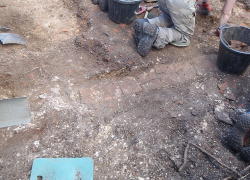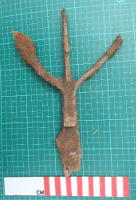14 Jul 2016
Forty Hall Summer Dig - Day 3

It was another great day's digging on the site of Elsyng Palace in Forty Hall today as we continue to reveal the layout of our (probably mid sixteenth century) building.
The line of tiles we revealed yesterday has resolved into a definate wall line, but like the wall it runs parallel with, it is just a thin tile construction that probably supported a timber framed internal partition. The narrow (about 2 metres wide) strip these two wall lines define along the center of the trench may represent a corridor inside the palace building.
By mid aftertoon we'd found this new wall line turns a 90-degree angle, just like the first and although at this point the wall is also quite narrow it is of a much more substantial brick-built construction.
The reason for the two walls turning a corner and becoming more substantial is not yet clear, and since only a short stretch of each is inside the trench, it may well call for some small trench extensions tomorrow or at the weekend.

Today was also an excellent day for finds, which came thick and fast and in a great variety. We have now recovered a considerable number of glazed floor tile fragments leaving little doubt as to what the floors of our building were made of -- we have also revealed the remains of the mortar bedding they would have been laid in (as expected, the floor has been entirely robbed out).
Interestingly, all of the fragments we recovered showed considerable signs of wear, so much so that at the time of demolition many of the tiles would have had no glaze left on their upper surfaces at all -- testiment both to how long they were in place and to the lack of maintenence that ultimately led to the palace falling into disrepair and out of royal favour.
One of the nicer small finds we made today was the end of a bone hair pin (pictured) -- with carved decoration and even signs of colouring (it was probably green).

Perhaps the oddest find of the day, though, was a large lump of ironwork in a remarkably good state of preservation, which at first glance may look like an offensive weapon but is in fact a window fixture.
The lower end would have been set in brickwork probably outside a window, and the semi-ornamental spikes would have provided protection against intruders and would also have deterred the local bird population from perching on and defacing the palace facade.
It's a great (and very unusual) find that adds a little detail to the practicalities of running a palace, but also adds to a sense that the seventeenth century demolition crew weren't perhaps being as picky as they might have about salvaging resalable material.
We've now found a few items like this, such as the large amounts of window glass last year that would have been worth a reasonable amount of money at the time the palace was demolished, making it all the more surprising to find them. Whether the demolition crew were sloppy or had simply saturated the local market by the time they got to this part of the palace, it has provided us with a wealth of unusual and highly dateable finds, for which we're grateful, no doubt with more to come tomorrow!